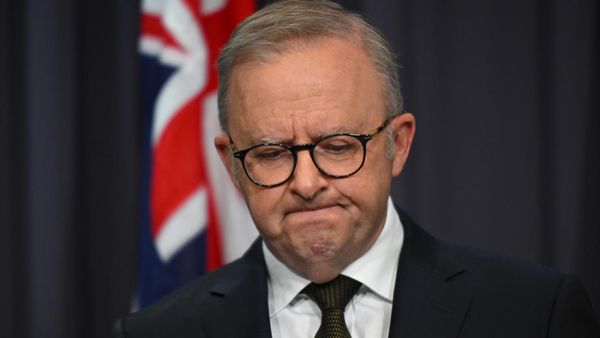
There’s always something a bit grim about the State of the Union. A setpiece of American political theater, the annual speech by the president to a joint session of Congress is choreographed to eliminate any chance of accidental sincerity. The president speaks in carefully calibrated spin; every word sounds like it has been focus-grouped. Members of the opposition party make a show of their animosity, vamping for the cameras with either staid, dignified displeasure or ravenous hatred, depending on where they are running for re-election. No one’s mind is changed and little new information is delivered. By its nature, the speech is meant to describe the status quo. It is not meant to change it.
This year, President Biden had a particularly grim task. After months and months of negotiations with Senator Joe Manchin, of West Virginia, proved fruitless, his sweeping economic agenda, the Build Back Better Plan, appears to be dead. The two voting rights bills that would have helped secure the franchise for Black Americans and protect the integrity of future elections were killed when Manchin and Senator Kyrsten Sinema, of Arizona, declined to support an exemption to the filibuster, meaning that the erosion of voting rights in Republican-controlled states is likely to advance unchallenged. Many economic indicators are strong, but with inflation running rampant, this means little to working families, who see their paychecks covering less and less of what they need. This spring, the US supreme court will hand down opinions that will drastically reshape American government and American lives, including the case from Mississippi, Dobbs v Jackson Women’s Health, that will overturn Roe v Wade. The midterms are coming, and in Europe, a pointless and brutal war of self-aggrandizement has been launched by an erratic and mendacious dictator with a massive stockpile of nuclear weapons.
Perhaps it was to be expected, then, that Biden’s speech was wide-ranging in tone, frenziedly ambitious in its agenda, and light on specifics. He opened with the Russian invasion of Ukraine, condemning the murderous ambitions of Vladimir Putin and praising the courage of the unexpectedly resilient Ukrainian military and civilian volunteer forces to rapturous applause. The Ukrainian ambassador to the United States, Oksana Markarova, was in attendance as a guest of the first lady, and she received the night’s first standing ovation, her hand placed over her heart from her balcony seat, as lawmakers below fluttered her country’s blue and yellow flag. Homages to the Ukrainian struggle were everywhere in the House chamber, with a number of women lawmakers dressed in blue and yellow ensembles, men and women alike wearing stickers of the Ukrainian flag on their lapels, and others fielding subtler signals of solidarity: when the camera lingered on Senator Elizabeth Warren, of Massachusetts, she had a cloth sunflower, the Ukrainian national symbol, pinned to her collar.
Biden boasted of the devastating impact of western economic sanctions on the Russian economy, reaffirmed his support for Nato, and vowed to deploy the justice department to seize yachts belonging to Putin’s friends. Promisingly, it seems as if concerns over growing Russian aggression might spark a renewed interest in energy independence that could help the US and Europe break their addiction to Russian oil and gas. Speaking of the recent return of significant numbers of American troops to Central Europe for the first time in years, Biden reaffirmed his commitment to preventing a direct military confrontation with Russia, and emphasized that the troops would be there not to attack the Russians, but to protect Nato allies. One suspects that Putin will not appreciate the distinction.

When Biden moved on to domestic policy, the crowd quickly became divided. As he touted his American Rescue Plan, last year’s Covid relief package, boos erupted from the Republican side when Biden noted that the 2017 Republican tax cuts had primarily benefitted the very rich. It was a theme he maintained as he turned to his bipartisan infrastructure law, the $1tn legislative achievement that provides funds for the maintenance and repair of the nation’s physical infrastructure – roads, bridges, airports, commuter trains, and internet. Biden touted a series of shovel-ready projects he claims will go into effect this year and emphasized the bill’s ability to encourage the return of the American manufacturing sector.
Domestic manufacturing was largely his prescription for fighting inflation, too. Biden introduced his broader economic agenda with a call to make more stuff in the US, and to use the federal government’s purchasing power to support those American-made goods. This segue led into a litany of briefly visited agenda items, such as allowing Medicare to negotiate prescription drug prices; cutting the cost of childcare for working class families so that more women could return to the paid workforce; establishing a 15% minimum corporate tax rate; and supporting the labor-strengthening Pro Act.
Many of these proposals seemed less like Biden was putting forward achievable goals for the next year of his presidency and more like he was shifting through the wreckage of his disastrous Build Back Better negotiations with Manchin, searching for some workable leftovers. Most of the items he proposed had already been presented to Congress; none of them had been able to get through the obstructionism of the Republican party and the Manchin-Sinema block. These things would substantially improve the lives of Americans, but it was clear he had no plan for how to implement any of them.
This was true especially for abortion rights. Though reproductive choice advocates had long urged Biden to say the word “abortion” in public – he has never done so as president – he referred tonight only offhandedly to the importance of reproductive rights. There was no mention of the fact that Roe v Wade has been nullified in the state of Texas for six months, as of Tuesday. There was no mention of the fact that the Reproductive Health Act, an attempt to legislatively secure the federal right to an abortion, failed in the Senate this week. There was no mention of the fact that of the five supreme court justices present at the speech, three of them – John Roberts, Brett Kavanagh, and Amy Coney Barrett – will vote to eliminate that right in a few short months. “We have to protect a woman’s right to choose,” said Biden, not offering any ideas as to just how that right might be protected. The camera cut momentarily to Amy Coney Barrett, who pursed her lips as thin as paper.
In this way, the speech was a perfect summation of Biden’s presidency: good intentions, with only halting, sporadic, uncreative, and trepidatious pursuit of actually enacting them. Unlike his predecessor, Biden tends to stay on script, but the State of the Union speech featured several ad libs – a product, some suspected, of the multiple revisions the speech was subjected to at the last minute, as Russia’s invasion of Ukraine placed new demands on the broadcast. The last of these was probably the most apropos: “Go get him,” Biden told the nation. Him who? Get him how? It didn’t make sense, but so little of this does.
Moira Donegan is a Guardian US columnist







